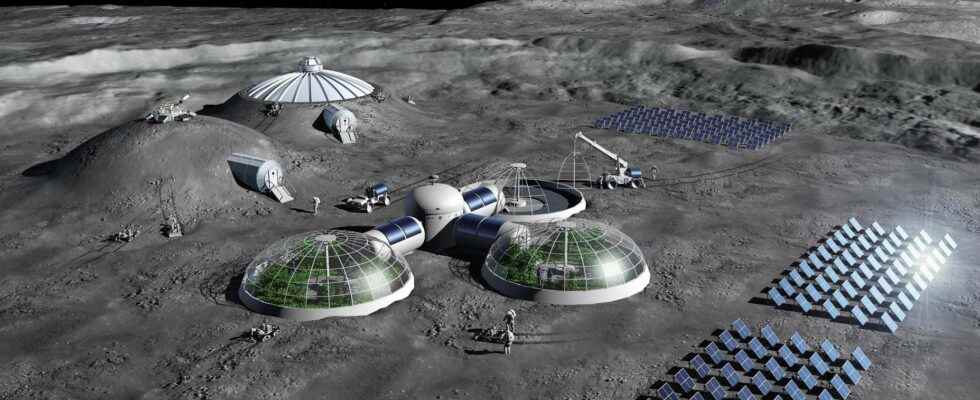We know that the volcanoes on Earth release water vapor during their eruptions. It was even thought for a time that all the water in the oceans came from condensation in L’atmosphere in cooling the young Earth of theHadean. Its water vapor content would then have been the product of an intense degassing volcanic of coat of the future Blue Planet during the first hundreds of millions of years of its existence. The presence of water in its mantle is a vestige of its primordial formation by accretion.
The subject of the origin of water in the oceans then became a little complicated because we asked ourselves the question of the precise initial quantity of water brought by accretion, from later arrivals in the form for example of comet and finally how this water ended up being stored in the bowels of the Earth. In this regard, an interesting theory was proposed recently by the great Russian physicist and crystallographer Artem Oganov and his colleagues.
Volcanoes and the lunar atmosphere
The Earth is not the only rocky body in the Solar system where significant volcanic activity has occurred. This is unquestionably the case of the Moon during its first two billion years as already shown by the basins basalt lunar seas but also photographs of its surface, photographs which suggest that volcanic eruptions could still happen today. We can therefore ask ourselves the question of the existence of an initial lunar atmosphere which would also have been born during the first hundreds of millions of years of the Moon by degassing and with a certain water vapor content.
The field of gravity of the Moon being however clearly weaker than that of the Earth and since it no longer possesses either for billions of years a magnetic field protective against atmospheric erosion that can be caused by winds and solar flares, our satellite cannot retain a dense atmosphere. The kinetic theory of gasoriginally developed by James Maxwell and later by Ludwig Boltzmannmakes it possible to calculate an evaporation in space of a lunar atmosphere which would be very rapid on the time scale of the geology on Earth which is counted in units of a million years.
One can also ask the question of the initial content of the Moon in water. It is problematic in the framework of the model with a giant impact giving birth to our satellite following a violent collision between the young Earth and a planet the size of Mars, the famous Theia. The Moon would indeed then have formed by accretion of the debris of the collision at high temperatures. We could therefore expect a priori to a Moon devoid of water because resulting from a massive evaporation of a very hot matter. But it seems, according to the study of lunar rocks, that the water content of the lunar mantle is not as low as one might think.
From numerical simulations conducted by a group of researchers from the Department of Science astrophysics planetary systems (APS) and the Laboratory of physical Atmospheric and Spatial (LASP) in Boulder (United States) therefore take on their full meaning in this context. The results obtained with them were published in an article by The Planetary Science Journal and they allow to think that there are important reserves of ices resulting from a condensation of the vapor produced by the great lunar eruptions between 2 and 4 billion years ago which one could find at the lunar poles .
A sci-fi documentary about the future of lunar colonies with an accelerated look at the future of life on the Moon. The exploitation of lunar ice is presented. To obtain a fairly accurate French translation, click on the white rectangle at the bottom right. The English subtitles should then appear. Then click on the nut to the right of the rectangle, then on “Subtitles” and finally on “Translate automatically”. Choose “French”. © Venture City, NASA, ESA, SpaceX, ESA + Foster and Partners, Vladimir Vustyansky, ESO/M. Kornmesser, Space of Relativity
Transient atmospheres produced by large eruptions
A few years ago, planetary scientists from Lunar and Planetary Institute of Houston had shown that these eruptions could have formed each time a transitory atmosphere of carbon monoxide and water vapor, especially during a peak of volcanic activity 3.5 billion years ago, an atmosphere that can be 1.5 times thicker than that on Mars today.
The Boulder researchers refined this scenario by showing that the eruptions of tens of thousands of volcanoes generating huge rivers and lakes of wash between 2 and 4 billion years ago would have allowed the repeated formation of atmospheres that could last about 2,500 years before disappearing into space by evaporation.
The simulations then show that about 41% of the water vapor emitted by the eruptions could have condensed in the famous polar regions of the Moon at the level of certain craters partially in an eternal shadow for billions of years. The amount of trapped water could then reach 8.2 × 1015 kg.
It has been speculated for decades about the existence of these deposits of ice that may also have originated, as originally thought, from the condensation of water vapor released from cometary impacts on the Moon during its first billion years, as the bombardment of small bodies celestial was more important than today.
The reserves of ice of volcanic origin could be under 5 to 10 meters of regolithwhich should not be a serious problem for future lunar settlers who could then use this water as well to grow plants or build up reserves of fuel and oxidizer in the form of oxygen andhydrogen liquid.
Future colonists could then drink water from lunar volcanoes, unless it is also or mostly water from comets.
Interested in what you just read?
